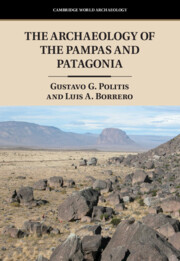Book contents
- The Archaeology of the Pampas and Patagonia
- Cambridge World Archaeology
- The Archaeology of the Pampas and Patagonia
- Copyright page
- Dedication
- Contents
- Acknowledgments
- Chapter 1 Introduction
- Chapter 2 Historical Background
- Chapter 3 Resources: Prey, Plants, and Stones
- Chapter 4 The Early Peopling: The Late Pleistocene to Early Holocene
- Chapter 5 The Middle Holocene (~ 8200–4200 cal BP; ~ 7500–3800 BP)
- Chapter 6 The Late Holocene Diversification (~ 4200 cal BP to ~ 400 cal BP; ~ 3800 BP to ~ 400 BP)
- Chapter 7 Final Remarks
- Select Bibliography
- Index
Chapter 2 - Historical Background
Published online by Cambridge University Press: 14 February 2024
- The Archaeology of the Pampas and Patagonia
- Cambridge World Archaeology
- The Archaeology of the Pampas and Patagonia
- Copyright page
- Dedication
- Contents
- Acknowledgments
- Chapter 1 Introduction
- Chapter 2 Historical Background
- Chapter 3 Resources: Prey, Plants, and Stones
- Chapter 4 The Early Peopling: The Late Pleistocene to Early Holocene
- Chapter 5 The Middle Holocene (~ 8200–4200 cal BP; ~ 7500–3800 BP)
- Chapter 6 The Late Holocene Diversification (~ 4200 cal BP to ~ 400 cal BP; ~ 3800 BP to ~ 400 BP)
- Chapter 7 Final Remarks
- Select Bibliography
- Index
Summary
In this chapter, the historical background of the archaeology in the Pampas and Patagonia is discussed and summarized. It encompasses a period of about 100 years, between the 1870s when the first archaeological investigations took place in the Pampas and Patagonia (Ameghino 1880–1881; Holmberg 1884; Moreno 1874; Moseley 1892; Zeballos and Pico 1878) and the late 1970s when there was a theoretical and methodological shift in the archaeology of both regions, which gave rise to modern research. The current regional models in the Pampas and Patagonia are a product of this last period’s research, first with a processual orientation and then adding other theoretical approaches (evolutionary, processual-plus/neo-processualism, post-processualism, etc.). However, some of the data and ideas generated in this first 100 years of investigation are still present in contemporary debates, as shown in the following chapters of this book.
- Type
- Chapter
- Information
- The Archaeology of the Pampas and Patagonia , pp. 27 - 66Publisher: Cambridge University PressPrint publication year: 2024

